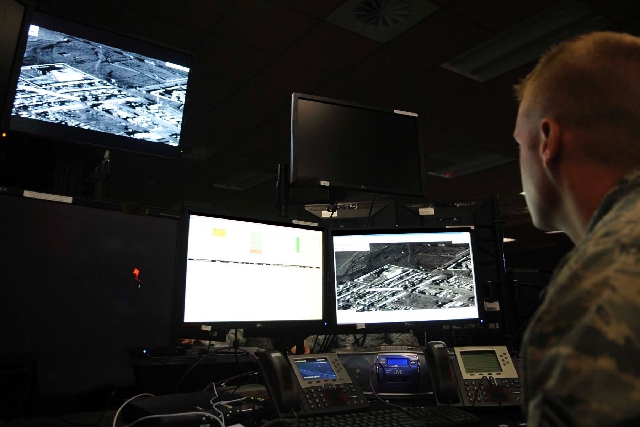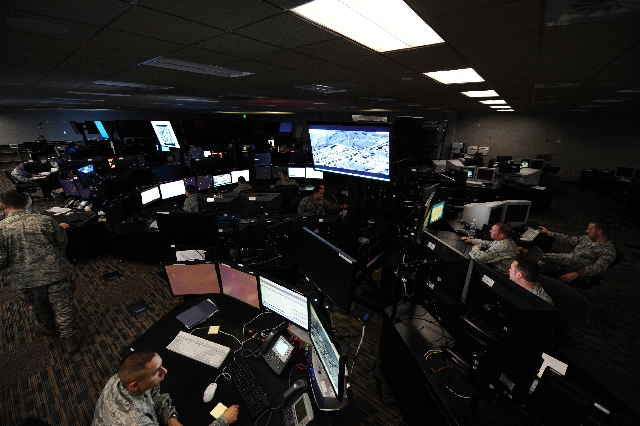Computer analysts display combat stress while working miles away


LANGLEY AIR FORCE BASE, Va. — They may never come face to face with a Taliban insurgent, never dodge a roadside bomb or take fire, but they still may be responsible for taking lives or putting their own colleagues in mortal danger. And now the military has begun to grapple with the mental and emotional strains endured by these Air Force personnel.
While they are thousands of miles from the gritty combat in Afghanistan, the analysts in the cavernous room at Langley Air Force Base in Virginia relive the explosions, the carnage and the vivid after-battle assessments of the bombings over and over again. The repeated exposure to death and destruction rolling across their computer screens is taking its own special toll on their lives.
Now, for the first time, an Air Force chaplain and a psychologist are walking the floor of the operations center at Langley, offering counseling and stress relief to the airmen who scrutinize the war from afar.
The war stress problem caught the attention of commanders at Creech Air Force Base at least five years ago when pilots and young sensor operators of remotely piloted aircraft sought a chaplain or supervisor on “four or five occasions,” according to one former commander.
About the same time, the lingering effects of reviewing video from drone missile strikes also affected Predator crews in a reconnaissance wing at March Air Reserve Base, Calif.
Officials at the Creech base, 45 miles northwest of Las Vegas at Indian Springs, had no immediate reaction Monday to reports of war stress at Langley Air Force Base.
They did release a statement late Monday saying, “Creech airmen receive strong leadership support and, when necessary, are supported by operational psychologists, chaplains and counselors who provide the same services available at any other Air Force installation.”
“The Air Force is committed to providing the best care possible for every airman, regardless of the reasons why,” reads the statement from Creech public affairs.
The former commander of the 432nd Wing at Creech, Col. Chris Chambliss, acknowledged the problem in a 2008 interview.
“You do stick around and see the aftermath of what you did, and that does personalize the fight,” Chambliss said at the time. “The images can be pretty graphic, pretty vivid, and those are the things we try to offset. We know that some folks have, in some cases, problems.”
Sitting at computer banks lining the expansive room, the Air Force analysts at Langley watch the video feeds streaming from surveillance drones and other military assets monitoring U.S. forces around the globe. Photos, radar data, full-motion video and electronically gathered intelligence flows across multiple screens. In 15- to 20-minute shifts, the airmen watch and interpret the information.
Through chat windows, they exchange data, update intelligence reports and talk in real time with commanders on the ground, including troops whose lives may depend on the constant and rapid flow of information they get from Langley.
They may provide information that allows a commander to order an airstrike, but after the weapon is launched, the analysts might suddenly see that the insurgents are fleeing or that civilians or children are moving into the strike zone, and by then they are helpless to do anything about it.
“If you have a 21-year-old playing a video game, when the game is over they start again. Here, if they miss a bad guy, that’s what they carry with them,” said Air Force Maj. Shauna Sperry, a psychologist who has just begun working with the air wing.
They also often have to go over video of an incident repeatedly to assess the battle damage.
“It’s not a video game, it’s real,” said Capt. Robert Duplease, the chaplain assigned to the 497th Intelligence, Surveillance and Reconnaissance Group. “It’s repeated exposure to destruction and warfare. They see it, rewind it, see it, rewind it.”
The analysts who provide this information to ground troops are stationed at six Air Force bases around the world, including South Korea, Germany and four U.S. bases. The wing at Langley number 1,200 airmen, both male and female, enlisted personnel and officers, but most around 19 to 21 years old.
The reality is spelled out in the list of daily mission assignments displayed on a multicolored chart cluttered with boxes, letters and numbers: where the missions are, what type of aircraft or sensors are being used, and which team of airmen is assigned to monitor each one. Two to seven analysts make up the teams that work at each workstation.
The idea to put a chaplain inside the center came from unit commander Col. Mike Shortsleeve and other leaders who noticed that some members of the wing were having problems sleeping and that smoking, alcohol and behavioral issues were increasing. In surveys, airmen also suggested there was a need for having a chaplain in the unit.
According to Duplease and Sperry, moving around the operations center during each day’s 12-hour shifts helps get the troops more comfortable with their presence and encourage them to reach out for help. Duplease, who said he also attended mission briefings, said slowly people began to approach him and after about two months, the interactions really began to pick up.
Many of the analysts are as young as 21 and may not yet have developed the ability to deal with the stress. And they worry that revealing their problems could prompt commanders to take away their security clearances or hurt their promotion opportunities.
In response, Duplease and Sperry created sleep classes and counseling sessions, and they have scheduled retreats for married couples and singles to help instill relationship and coping skills. They also are assuring the airmen that to date no one there has lost his or her security clearance as a result of seeking any counseling or assistance.
Review-Journal writer Keith Rogers contributed to this report.
Medal may face change
WASHINGTON — The leaders of the Senate Armed Services Committee have added their names to the growing list of lawmakers asking the Pentagon to lower the ranking of a new medal for cyber fighters.
The proposed Distinguished Warfare Medal would rank ahead of the Bronze Star and Purple Heart.
Sen. Carl Levin, the committee’s Democratic chairman, and Sen. Jim Inhofe, the committee’s top Republican, asked Defense Secretary Chuck Hagel to reflect on his combat experience in Vietnam. In a letter, they said they were concerned about the message the medal’s ranking sends to those who served in harm’s way.
The new medal is a sign of the changing nature of war and would honor drone pilots and others who use their technological skills to gather intelligence and kill enemy fighters.
the associated press












